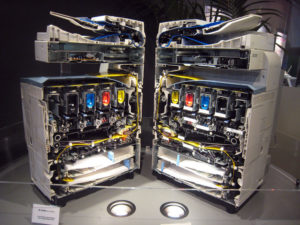The Intricate Insides of a Copier
Standing and waiting for a machine to copy endless duplications of those TPS reports your boss hounded you for by 5pm, can be…well…boring. Unless of course you have the “Canon imageRUNNER ADVANCE 8200 series“, which is capable of up to 105 pages per minute, but if not, here’s a little information that may make you appreciate the science of copying while you wait.
1. You place the document you want to copy upside down on the glass
2. An extremely bright light scans across the document. Much more light reflects off the white areas (where there is no ink) than off the black, inked areas.
3. An “electrical shadow” of the page forms on the photoconductor. The photoconductor in a photocopier is a rotating conveyor belt coated with a chemical called selenium.
4. As the belt rotates, it carries the electrical shadow around with it.
5. An ink drum touching the belt coats it with tiny particles of powdered ink (toner).
6. The toner has been given an electrical charge, so it sticks to the electrical shadow and makes an inked image of the original page on the belt.
7. A sheet of paper from a hopper on the other side of the copier feeds up toward the first belt on another conveyor belt. As it moves along, the paper is given a strong electrical charge.
8. When the paper moves near the upper belt, its strong charge attracts the charged toner particles away from the belt. The image is rapidly transferred from the belt onto the paper.
9. The inked paper passes through two hot rollers (the fuser unit). The heat and pressure from the rollers fuse the toner particles permanently onto the paper.
10. The final copy emerges from the side of the copier. Thanks to the fuser unit, the paper is still warm. It may still have enough static electric charge to stick to your pullover. Try it (but make sure the ink is dry first).
Note: Toner is actually made from carbon and plastic, not ink.

